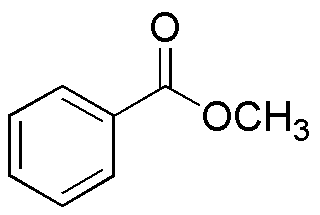Methyl benzoate is widely utilized in research focused on:
- Fragrance Industry: Commonly used as a key ingredient in perfumes and scented products, it provides a pleasant floral aroma, enhancing the appeal of personal care items.
- Flavoring Agent: Employed in the food industry, it acts as a flavoring agent in various food products, particularly in candies and beverages, to impart a sweet, fruity taste.
- Solvent Applications: Used as a solvent in organic synthesis, it helps dissolve various organic compounds, making it valuable in laboratories for chemical reactions and extractions.
- Pharmaceuticals: Acts as an intermediate in the synthesis of various pharmaceuticals, contributing to the development of drugs with specific therapeutic effects.
- Polymer Production: Utilized in the production of polymers and resins, it enhances the properties of materials used in coatings and adhesives, improving durability and performance.
General Information
Properties
Safety and Regulations
Applications
Methyl benzoate is widely utilized in research focused on:
- Fragrance Industry: Commonly used as a key ingredient in perfumes and scented products, it provides a pleasant floral aroma, enhancing the appeal of personal care items.
- Flavoring Agent: Employed in the food industry, it acts as a flavoring agent in various food products, particularly in candies and beverages, to impart a sweet, fruity taste.
- Solvent Applications: Used as a solvent in organic synthesis, it helps dissolve various organic compounds, making it valuable in laboratories for chemical reactions and extractions.
- Pharmaceuticals: Acts as an intermediate in the synthesis of various pharmaceuticals, contributing to the development of drugs with specific therapeutic effects.
- Polymer Production: Utilized in the production of polymers and resins, it enhances the properties of materials used in coatings and adhesives, improving durability and performance.
Documents
Safety Data Sheets (SDS)
The SDS provides comprehensive safety information on handling, storage, and disposal of the product.
Product Specification (PS)
The PS provides a comprehensive breakdown of the product’s properties, including chemical composition, physical state, purity, and storage requirements. It also details acceptable quality ranges and the product's intended applications.
Certificates of Analysis (COA)
Search for Certificates of Analysis (COA) by entering the products Lot Number. Lot and Batch Numbers can be found on a product’s label following the words ‘Lot’ or ‘Batch’.
*Catalog Number
*Lot Number
Certificates Of Origin (COO)
This COO confirms the country where the product was manufactured, and also details the materials and components used in it and whether it is derived from natural, synthetic, or other specific sources. This certificate may be required for customs, trade, and regulatory compliance.
*Catalog Number
*Lot Number
Safety Data Sheets (SDS)
The SDS provides comprehensive safety information on handling, storage, and disposal of the product.
DownloadProduct Specification (PS)
The PS provides a comprehensive breakdown of the product’s properties, including chemical composition, physical state, purity, and storage requirements. It also details acceptable quality ranges and the product's intended applications.
DownloadCertificates of Analysis (COA)
Search for Certificates of Analysis (COA) by entering the products Lot Number. Lot and Batch Numbers can be found on a product’s label following the words ‘Lot’ or ‘Batch’.
*Catalog Number
*Lot Number
Certificates Of Origin (COO)
This COO confirms the country where the product was manufactured, and also details the materials and components used in it and whether it is derived from natural, synthetic, or other specific sources. This certificate may be required for customs, trade, and regulatory compliance.


